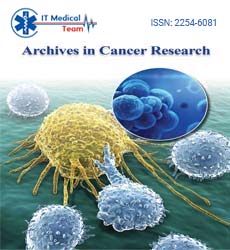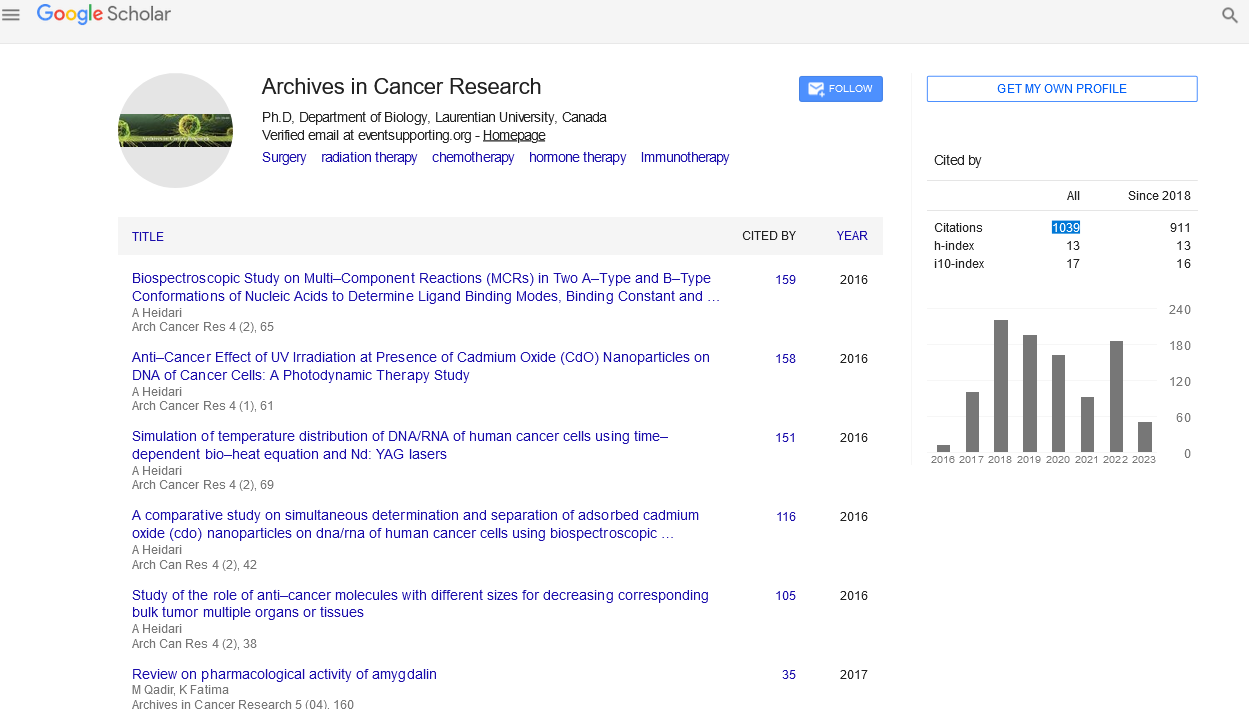Naoyuki Hayashi and Chiaki Takahashi*
Division of Oncology and Molecular Biology, Cancer Research Institute, Kanazawa University, Kakuma-machi, Kanazawa, Ishikawa 920-1192, Japan
- *Corresponding Author:
- Chiaki Takahashi
Division of Oncology and Molecular Biology
Cancer Research Institute
Kanazawa University
Kakumamachi,
Kanazawa, Ishikawa 920-1192
Japan
Tel: +81-76-264-6750
E-mail: chtakaha@staff.kanazawa-u.ac.jp
Received Date: May 20, 2021; Accepted Date: June 03, 2021; Published Date: June 10, 2021
Citation: Hayashi N, Takahashi C (2021) Brief Report on Diagnostic Mesenchymal Tumors. Arch Cancer ResVol.9 No.S4:003
Keywords
Uterine leiomyomas; Gastrointestinal tumor; Hepatectomy
Introduction
The Uterine leiomyomas are the most well-known tumors to influence ladies, and can cause pelvic distress and menorrhagia [1]. Then again, Gastrointestinal Stromal Tumors (GISTs) are the most widely recognized mesenchymal tumors of the gastrointestinal plot, and are regularly asymptomatic [2]. There have been not many reports of uterine fibroids copying different tumors, a circumstance where the conclusion is testing and may at times result in a misdiagnosis. Here we report a case, and present the noteworthy pictures for a case in which a woman with uterine leiomyoma was at first idea to have a colonic GIST.
Hematological Examinations
Madam S is a 41 year old Indonesian woman who has a previous clinical history of uterine fibroids, on circle back to a gynecologist. She introduced to the clinic with grumblings of serious right upper quadrant torment of 2 days term. There was no fever, change in entrail propensities, per-rectal draining or regurgitating. On assessment, she was ready however in gentle trouble. She was not pale, nor embittered. Her midsection was delicate absurd upper quadrant with restricted guarding however no proof of peritonism. There was likewise a huge mass felt over a similar area. Hematological examinations were generally unexceptional with the exception of a hemoglobin of 10 g/dl (ordinary reach: 12-15.5 g/dl) and raised complete white cell check of 14.5^1000 (typical reach: 4.50 to 10.0^1000). Tumor markers were performed, and the CA-125 was noted to be raised at 71.4 U/ml (typical reach: <35 U/ml).
A CT output of her mid-region and pelvis was done earnestly around the same time of affirmation. Discoveries on the output showed an enormous heterogenous mass in the upper midregion, uprooting the adjoining structures and was indivisible from the proximal cross over colon. Furthermore, different discoveries remember a potential fibroid for the back uterine divider and respective cystic masses.
Discussion
Uterine leiomyomas are the most well-known generous gynecological tumors. They show up as round, all around delineated strong knobs and display a traditionally portrayed 'whorled-like' apperance on histological investigation. A normal leiomyoma is effortlessly analyzed on imaging, and the majority of them might be unhesitatingly analyzed utilizing sonography. The introduction of uterine leiomyomas can contrast from one patient to another. They do lead to entanglements like dying, sickliness, flawed implantation of an incipient organism and pelvic distress [3]. Moreover, assuming huge, they may mimick other harmful condition, with a case report portraying a retroperitoneal leiomyoma emulating a sarcoma [4]. There likewise have been other case reports which depict uterine leiomyoma imitating GIST [5] just as emulating a stomach mass [6] which introduced as a symptomatic problem to the clinicians. This certainly presents as an indicative test as the executives of the patient would then vary.
Substances constitue most of gastrointestinal mesenchymal tumors of the GIT and are known to be obstinate to ordinary chemotherapy or radiation. They structure 0.1%-3% of gastrointestinal harmful tumors [7,8]. Up to 70% of patients with GIST are suggestive, with obscure stomach uneasiness being the most widely recognized grievance (60-70%). The imaging of decision is a differentiated figured tomography (CT) output and they CT check showing the mass that is indivisible from the colon, in coronal segment. Show up as huge, distinct oft tissue mass with heterogenous improvement. They are typically of fluctuating thickness and show inconsistent improvement after intravenous differentiation.
Diagnosing uterine leiomyomas can be troublesome and testing if the presence of the uterine mass isn't commonplace on imaging. They traditionally seem strong in echogenic terms (however might be marginally hypoechoic if throughtransmission or infiltration is poor) [9].
This features the significance of securing the finding as the administration and forecast would contrast in the event that it was a harmful condition rather than uterine leiomyoma. Jeong G.U. has revealed an instance of retroperitoneal leiomyoma impersonating a sarcoma where the mass was as yet suspected to be a sarcoma even on MRI imaging. The patient was then anticipated an extreme resection. They discovered a tumor which was appended to the uterus and histology returned as subserosal uterine leiomyoma. The forecast for a sarcoma fluctuates limitlessly from that of uterine leiomyoma – it is poor in view of forceful course and high nearby repeat rates [10].
38350
References
- Gupta S, Manyonda IT (2009) Acute complications of fibroids. Best Prac Res Clin Obstet Gynaecol 23(5): 609-617.
- Miettinen M, Lasota J (2001) Gastrointestinal stroma tumours – definition, clinical histological, immunohistochemical and molecular genetic features and differential diagnosis. Virchows Arch 438(1): 1-12.
- Jeong GA (2014) Retroperitoneal leiomyomas of the uterus mimicking sarcoma in perimenopausal women: Case report. J Menopausal Med 20(3): 133-137.
- Kim KW (2005) Incidence of GIST in Koreans: It’s incidence and the clinical, pathologic and immunohistochemical findings. J Korean med Sci 20: 977-984.
- Goettsch WG, Bos DS, Breekveldt-Postma N, Casparie M, Herings RMC, et al. (2005) Incidence of GIST is underestimated: results of a nation-wide study. Eur J Cancer 41(18): 2868-2872.
- Zhu XQ, Fei J, Zhang W, Zhou J (2015) Uterine leiomyoma mimicking a gastrointestinal stromal tumour with chronic spontaneous hemorrhadge: A case report. Oncol lett 9(6): 2481-2484.
- Low SC, Chong CL (2004) A case of cystic leiomyoma mimicking an ovarian malignancy. Ann Acad med Singapore 33(3): 371-374.
- Kalayci TO, Akatlı AN, Sönmezgöz F, Türkmen Şamdancı E (2015) A giant subserosal uterine leiomyoma mimicking an abdominal mass: multimodal imaging data. Acta Med Iran. 53(4):246-9.
- Erzen D, Sencar M, Novak J (2005) Retroperitoneal sarcoma: 25 years of experience with aggressive surgical treatment at the Institute of Oncology, Ljubljana. J Surg Oncol 91(9): 1-9.





